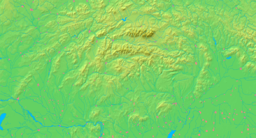- Sládkovičovo
-
For the Romanian village of Tuta, called Diószeg in Hungarian, see Târgu Trotuş.
Sládkovičovo Diószeg Town Country Slovakia Region Trnava District Galanta Tourism region Dolné Považie River Dudváh Elevation 120 m (394 ft) Coordinates 48°12′19″N 17°38′39″E / 48.20528°N 17.64417°E Area 29.095 km2 (11.234 sq mi) Population 5,677 (2005) Density 195 / km2 (505 / sq mi) First mentioned 1252 Mayor Anton Szabó Timezone CET (UTC+1) - summer (DST) CEST (UTC+2) Postal code 925 21 Area code +421-31 Car plate GA Statistics: MOŠ/MIS Website: www.sladkovicovo.net Sládkovičovo (until 1948 Diosek, German: Diosek, Hungarian: Diószeg) is a town in the Galanta District, Trnava Region in southwestern Slovakia.
Contents
Geography
It is located on the Danubian Lowland, in the region known as Dolné Považie (Lower Váh region) on the Dudváh river, around 45 km east of Slovak capital Bratislava and 8 km from district seat Galanta.
History
The first written record about the town was in 1252 in a document of King Béla II of Hungary, possibly named after a forest with walnut trees.[1] In 1530 it was raided by the Ottomans. It received town privileges in 1582 and in the 17th century a royal way was passing through the town, but in 1709 the town burned down. Throughout time, the Church, later Erdődys, Esterházys and in the 19th century Zichys owned the town. During the reign of Joseph II, German farmers and craftsmen settled in the village and two separate villages were created - smaller German Diószeg and larger Hungarian Diószeg. In 1850 a railway track from Pressburg to Budapest was built and the town gained a railway station and in 1867 a sugar factory was built. Later in 1870 the settlement got renewed town privileges. After break-up of Austria-Hungary in 1918, the town passed into Czechoslovakia, confirmed by the Treaty of Trianon in 1920. As a result of the First Vienna Award the town belonged from 1938 to 1945 to Hungary. In 1948 the town was renamed from Diosek to Sládkovičovo in the honor of Andrej Sládkovič, a Slovak poet.
Demographics
According to the 2001 census, the town had 6,078 inhabitants. 59.46% of inhabitants were Slovaks, 38.50% Hungarians, 0.92% Roma and 0.53% Czechs.[2] The religious makeup was 66.78% Roman Catholics, 18.02% people with no religious affiliation and 9.62% Lutherans.[2]
Partner towns
References
- ^ History of the town (Slovak)
- ^ a b "Municipal Statistics". Statistical Office of the Slovak republic. Archived from the original on 2008-01-11. http://web.archive.org/web/20080111223415/http://www.statistics.sk/mosmis/eng/run.html. Retrieved 2008-01-16.
External links
Galanta · Sereď · Sládkovičovo
Abrahám · Čierna Voda · Čierny Brod · Dolná Streda · Dolné Saliby · Dolný Chotár · Gáň · Horné Saliby · Hoste · Jánovce · Jelka · Kajal · Košúty · Kráľov Brod · Matúškovo · Mostová · Pata · Pusté Sady · Pusté Úľany · Šalgočka · Šintava · Šoporňa · Tomášikovo · Topoľnica · Trstice · Váhovce · Veľká Mača · Veľké Úľany · Veľký Grob · Vinohrady nad Váhom · Vozokany · Zemianske Sady Categories:
Categories:- Cities and towns in Slovakia
Wikimedia Foundation. 2010.




